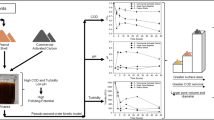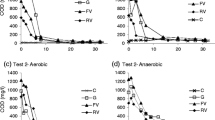Abstract
Vinasse sugarcane is a valuable byproduct of the ethanol production process, presenting a perspective of volume increase with the development of second generation ethanol (2GE). However, this byproduct needs new methods of treatment and management for sustainability. Besides that, 2GE vinasse can be associated with some compounds (such as furan derivatives, phenolic compounds and organic acids), depending on the process used to solubilize hemicellulose, which could compromise vinasse destination or utilization. For this reason, detoxification methods of the hemicellulosic hydrolysates, from which vinasse is obtained in subsequent steps, are crucial. This study aimed to investigate whether the biological detoxification of vinasse from 2GE presents a difference concerning the microbial activity of biodegradation and toxicity when compared to vinasse without the detoxification process. Two vinasses (1, before; and 2, after detoxification) from fermented sugarcane bagasse (hemicellulose fraction) acid hydrolysate (supplemented with its molasses), under different concentrations: 2.5; 5 e 10% were evaluated. Their physicochemical characterization, biodegradation microbial activity (through Bartha and Pramer respirometric method, with total count of heterotrophic bacteria and fungi), and toxicity evaluation (through bioassays with Lactuca sativa at concentraction: 2.5; 5 e 10% and Daphnia similis to 1.5; 2.5; 3.5; 4.5; 5 and 10%) were performed. The results indicated high mineral and organic matter, which under a specific circumstance (2.5% of soil conditioning), enabled high efficiency in biodegradation (>80%). The bioassays with L. sativa signaled negative effect for radicular growth when the vinasses were applied at a concentration of 5 and 10% (sublethal effect and delayed root growth). Acute effects were observed in D. similis, with 50% of immobilization, at concentrations of 4.13% and 4.74% for vinasses 1 and 2, respectively. These results indicate that the biodegradation of vinasse from sugarcane bagasse acid hydrolysate occurs at relatively low levels (up to 5%) and suggests that higher concentrations (≥10%) may impair the growth of soil-associated microorganisms.



Similar content being viewed by others
Data availability
Data available on request from the authors.
References
Almeida LM de (2006) Crustacea. In: Ribeiro-Costa CR, Rocha RM (Coords). Invertebrados: Manual de Aulas Práticas. Ribeirão Preto: Editora Holos, 2. ed. p. 144.e145
Almeida NC, Tomasella RC, Govone S, Kinjo S, Angelis DF (2013) Study of stillage biodegradation by respirometry in sandy and clay soils. Afr J Agric 8:35
Alves PRL, Estrada-Bonilla GA, Bini D, Cardoso EJBN (2019) Changes in the microbial metabolism of agricultural tropical soils amended with sugarcane vinasses. Sugar Tech 21(2):364–369
AOAC - Association Official Analytical Chemist (2005) Official Methods of Analysis, 18th edn. AOAC International, Gaitherburg, MD
Aparicio JD, Benimeli CS, Almeida, Polti MA, Colin VL (2017) Integral use of sugarcane vinasse for biomass production of actinobacteria: potential application in soil remediation. Chemosphere 181:478–484
APHA Standard methods for the examination of water and wastewater (1998) American Public Health Association/American Water Works Association / Water Environment Federation, 20. ed. Washington, DC, USA
APHA Standard methods for the examination of water and wastewater (2012) American Public Health Association/American Water Works Association / Water Environment Federation, 22. ed. Washington, DC, USA
Baeyens J, Kang Q, Appels L, Dewil R, Yongqin LV, Tan T (2015) Challenges and opportunities in improving the production of bio-ethanol. Prog Energ Combust 47:60–88
Bartha R, Pramer D (1965) Features of flask and method for measuring the persistence and biological effects of pesticides in soil. Soil Sci 100(1):68–70
Buratini SV, Bertoletti E, Zagatto PA (2004) Evaluation of Daphnia similis as a test species in ecotoxicological assays. Bull Environ Contam Toxicol 73:878–882
Candido JP, Claro EMT, de Paula CBC, Shimizu FL, Leite DANO, Brienzo M, Angelis DF (2020) Detoxification of sugarcane bagasse hydrolysate with different adsorbents to improve the fermentative process. World J Microb Biot 36:43
CETESB. Environmental Sanitation and Technology Company (1984) Soil-collection and sample preparation procedures. São Paulo: Technical Standard L6. 245
Christofoletti CA, Pedro-Escher J, Correia JE, Marinho JFU, Fontanetti CS (2013) Sugar cane vinasse: environmental implications of its use. Waste Manag 33:2752–2761
Coelho MPM, Correia JE, Vasquesa LI, Marcato ACC, Guedes TA, Sotob MA, Bassob JB, Kiang C, Fontanetti CS (2018) Toxicity evaluation of leached of sugarcane vinasse: histopathology and immunostaining of cellular stress protein. Ecotox Environ Safe 165:367–375
de Almeida, LM, Crustacea (2006) Invertebrados: Manual de Aulas Práticas, 2nd edn. In: Ribeiro-Costa, C.R.; Rocha, R.M. (Coords). Ribeirão Preto: Editora Holos, p. 144e–145
EPA / U.S. Environmental Protection Agency (1996) Ecological Effects Test Guidelines OPPTS850.4200 Seed Germination/Root Elongation Toxicity Test. 712c, 96–154
España-Gamboa E, Mijangos-Cortes J, Barahona-Perez L, Dominguez- Maldonado J, Hernández-Zarate G, Alzate-Gaviria L (2011) Vinasses: characterization and treatments. Waste Manage Res 29:1235–1250
Ferreira LFR, Aguiar MM, Messias TG, Pompeu GB, Lopez AMG, Silva DP, Monteiro RT (2011) Evaluation of sugar-cane vinasse treated with Pleurotus sajor-caju utilizing aquatic organisms as toxicological indicators. Ecotox Environ Safe 74(1):132–137
Goldin A (1987) Reassessing the use of loss-on-ignition for estimating organic matter content in noncalcareous soils. Commun Soil Sci Plant Anal 18:1111–1116
Gruposo Silveira, CJ, Melo Santa Anna, LM, Machado de Castro, A, Nogueira Moyses, D, Da Conceição Gomes, A, Martins Bandeira, LF, Cammarota, MC, De Carvalho Alves, L, Camporese Sérvulo, EF (2012) Method for producing energy-rich gases from lignocellulosic material streams. Patent Process: WO 2012/003556 Al
Gutiérrez-Rivera B, Ortiz-Muniz B, Gómez-Rodríguez J, Cárdenas-Cagal A, González JMD, Aguilar-Uscanga MG (2015) Bioethanol production from hydrolyzed sugarcane bagasse supplemented with molasses “B” in a mixed yeast culture. Renew Energ 74:399–405
Hamilton MA, Russo RC, Thurfton RB (1977) Trimmed Spearman-Karber method for estimating median lethal concentration in toxicity bioassays. Environ Sci Technol 11:714–719
Hoarau J, Caro Y, Grondin I, Petit T (2018) Sugarcane vinasse processing: toward a status shift from waste to valuable resource a review J Water Process Eng 24:11–25
ISO 11269-2, (1995) Soil quality-determination of the effects of pollutants on soil flora. Part 2: effects of chemicals on the emergence of higher plants. International Organization for Standardization, Genève, Switzerland
Kumar, AK, Sharma, S (2017) Recent updates on different methods of pretreatment of lignocellulosic feedstocks: a review. Bioresour Bioprocess. 4 (7)
Lutterbeck CA, kern DI, Machado EL, Kummerer K (2015) Evaluation of the toxic effects of four anti-cancer drugs in plant bioassays and its potency for screening in the context of waste water reuse for irrigation. Chemosphere 35:403–410
Lyu J, Park J, Pandey KL, Choi S, Lee H, De Saeger J, Depuydt S, Han T (2018) Testing the toxicity of metals, phenol, effluents, and receiving waters by root elongation in Lactuca sativa L. Ecotoxicol Environ Saf 149:225–232
Madejón E, López R, Murillo JM, Cabrera F (2001) Agricultural use of three (sugar- beet) vinasse composts: effect on crop sand chemical properties of a Cambisol soil in the Guadalquivir river valley (SW Spain). Agric Ecosyst Environ 84:55–65
Mariano AP, Crivelaro SHR, Angelis DF, Bonotto DM (2009) The use of vinasse as an amendment to ex-situ bioremediation of soil and ground-water contaminated with diesel oil. Braz Arch Biol Technol 52:1043–1055
Melati RB, Shimizu FL, Oliveira G, Pagnocca FC, Souza W, Sant’Anna C, Brienzo M (2019) Key factors affecting the recalcitrance and conversion process of biomass. BioEnergy Res 12:1–20
Messetti MA, da Silva JA, Santos MG, Govone JS, Angelis DF (2017) Biodegradation and toxicity of waste from anaerobic fermentation of stillage. Afr J Biotechnol 16(37):1863–1870
Milanez AY, Nyko D, Valente MS, Sousa LC, Bonomi AMFLJ, Jesus CDF, Watanabe MDB, Chagas MF, Rezende MCAF, Cavalett O, Junqueira TL, Gouvêia VLR (2015) De promessa a realidade: como o etanol celulósico pode revolucionar a indústria da cana-de-açúcar: uma avaliação do potencial competitivo e sugestões de política pública. BNDES Setorial, Rio de Janeiro 41:237–294
Moraes BS, Petersen SO, Zaia TM, Sommer SG, Triolo JM (2017) Reduction in greenhouse gas emissions from vinasse through anaerobic digestion. Appl Energy 189:21–30
Moraes BS, Zaia TM, Bonomi A (2015) Anaerobic digestion of vinasse from sugarcane ethanol production in Brazil: challenges and perspectives. Renew Sust Energ Rev 44:888–903
OECD - Organization for Economic Cooperation and Development. Guideline 307., 2002. Guideline for the Testing of Chemicals. Aerobic and Anaerobic Transformation in Soil. OECD
OECD - Organization for Economic Cooperation and Development. Guideline 208., 2003. Terrestrial Plant Test: 208; Seedling Emergence and Seedling Growth Test. OECD
OECD - Organization for Economic Cooperation and Development. Guideline 317., 2010. Guideline for the Testing of Chemicals. Bioaccumulation in Terrestrial Oligochaetes. OECD
Parnaudeau V, Condom N, Oliver R, Cazevieille P, Recous S (2008) Vinasse organic matter quality and mineralization potential, as in fluenced by raw material, fermentation and concentration processes. Bioresour Technol 99:1553–1562
Ribeiro BT, Lima JMD, Guilherme LRG, Julião LGF (2010) Lead sorption and leaching from an Inceptisol sample amended with sugarcane vinasse. Sci Agric 67:441–447
Ribeiro FR, Passos F, Gurgel LVA, Baêta BEL, Aquino SF (2017) Anaerobic digestion of hemicellulose hydrolysate produced after hydrothermal pretreatment of sugarcane bagasse in UASB reactor. Sci Total Environ 584-585:1108–1113
Rodrigues Reis CE, Hu B (2017) Vinasse from sugarcane ethanol production: better treatment or better utilization?. Front Energy Res 5:2017
Régo APJ, Reganhan-Coneglian CM, Montagnolli RN, Bidoia ED (2014) CO2 production of soil microbiota in the presence of Ametryne and Biofertilizer Water Air Soil Pollut 225:2222
Silva MAS, Griebeler NP, Borges LC (2007) Uso de vinhaça e impactos nas propriedades do solo e lençol freático. Rev Bras Eng Agríc v.11:108–114
Silva-Fernandes T, Santos JC, Hasmann F, Rodrigues RCLB, Izario Filho HJ, Felipe MGA (2017) Biodegradable alternative for removing toxic compounds from sugarcane bagasse hemicellulosic hydrolysates for valorization in biorefineries. Biores Technol 243:384–392
Sobrero MC, Ronco A (2004) Ensayo de toxicidad aguda con semillas de lechuga (Lactuca sativa L.). In: G Castillo (ed.) Ensayos toxicológicos y métodos de evaluación de calidad de aguas. Estandarización, intercalibración, resultados y aplicaciones. Canadá: IDRC/IMTA. p. 490, 71–79
Stambuk BU, Eleutherio ECA, Florez-Pardo LM, Souto-Maior AM, Bom EPS (2008) Brazilian Potencial for biomass ethanol: challenge of using hexose and pentose co-fermentation yeast strains. J Sci Ind Res 67:918–926
Vallejos ME, Chade M, Mereles EB, Bengoechea DI, Brizuela JG, Felissia FE, Area MC (2016) Strategies of detoxification and fermentation for biotechnological production of xylitol from sugarcane bagasse. Ind Crop Prod 91:161–169
Velásquez-Riaño M, Meneses-Sánchez JS, Carvajal Arias CE (2019) Evaluation of acute toxicity of vinasse by means of Daphnia magna and Aliivibrio fischeri: a comparative study Interdiscip. Toxicol 12(3):143–148
Wilkie AC, Riedesel KJ, Owens JM (2000) Stillage characterization and anaerobic treatment of ethanolstillage from conventional and cellulosic feedstocks. Biomass Bioenerg 19:63–102
Zagatto PA, Bertoletti E (2008) Ecotoxicologia Aquática – Princípios e Aplicações. 2° Ed. São Carlos, SP. RiMA, 486 p
Funding
This study was financed in part by the Coordenação de Aperfeiçoamento de Pessoal de Nível Superior—Brasil (CAPES)—Finance Code 001. The authros are thankfull to the São Paulo Research Foundation (FAPESP, grant 2017/22401-8).
Author information
Authors and Affiliations
Contributions
DFA, DNOL and MB contributed to the study conception and design. JPC and ECA performed the study, analyzed the data and drafted the paper. DFA, DNOL and MB contributed to and approved the final paper. All authors commented on previous versions of the paper. All authors read and approved the final paper.
Corresponding author
Ethics declarations
Conflict of interest
The authors declare no competing interests.
Animal research
All applicable international, national, and/or institutional guidelines for the care and use of animals were followed.
Additional information
Publisher’s note Springer Nature remains neutral with regard to jurisdictional claims in published maps and institutional affiliations.
Supplementary information
Rights and permissions
About this article
Cite this article
Candido, J.P., Almeida, É.C., de Oliveira Leite, D.N. et al. Vinasse from sugarcane bagasse (hemicellulose) acid hydrolysate and molasses supplemented: biodegradability and toxicity. Ecotoxicology 30, 818–827 (2021). https://doi.org/10.1007/s10646-021-02401-w
Accepted:
Published:
Issue Date:
DOI: https://doi.org/10.1007/s10646-021-02401-w




